Chapter 1: Overview
Patterns of global migration and remittances have shifted in recent decades, even as both the number of immigrants and the amount of money they send home have grown, according to a new Pew Research Center analysis of data from the United Nations and the World Bank.
A rising share of international migrants now lives in today’s high-income countries such as the United States and Germany, while a growing share was born in today’s middle-income nations such as India and Mexico, the analysis finds.
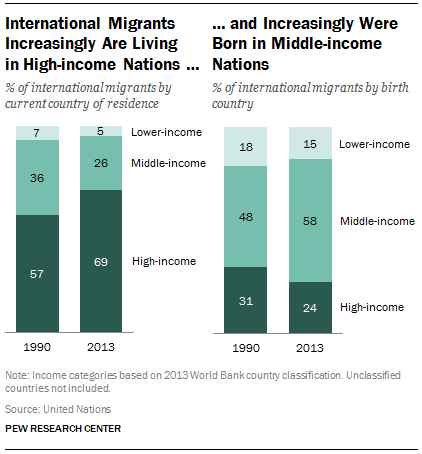 These shifts occurred as the total number of international migrants rose from 154 million in 1990 to 232 million in 2013 – but remained steady as a 3% share of the globe’s growing population.
These shifts occurred as the total number of international migrants rose from 154 million in 1990 to 232 million in 2013 – but remained steady as a 3% share of the globe’s growing population.
During this period, the U.S. remained the largest destination country by far and increased its share of the world’s migrants. One-in-five (46 million) migrants now live in the U.S., compared with slightly less than one-in-six (23 million) in 1990.
The U.S. is not the only wealthy destination country whose share of the world’s migrants has increased. All told, an estimated 160 million, or 69%, of international migrants now live in high-income countries (nations with an average per capita income of $12,616 or higher), up from 87 million, or 57%, in 1990, the Pew Research analysis finds. These high-income countries, many of them in North America and Europe, may appear increasingly attractive to modern migrants, whose principal reason for moving is to pursue economic opportunity.
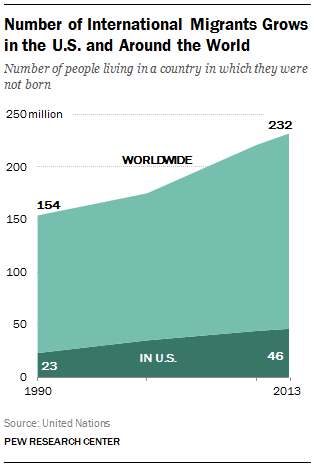 Where do today’s migrants come from? Increasingly, they were born in what the World Bank designates as middle-income countries, those with per capita annual income between $1,036 and $12,615. About six-in-ten (135 million) of today’s international migrants were born in such countries, compared with fewer than half (74 million) of all migrants in 1990. Over the same period, the share of immigrants born in high- as well as low-income nations has declined.1
Where do today’s migrants come from? Increasingly, they were born in what the World Bank designates as middle-income countries, those with per capita annual income between $1,036 and $12,615. About six-in-ten (135 million) of today’s international migrants were born in such countries, compared with fewer than half (74 million) of all migrants in 1990. Over the same period, the share of immigrants born in high- as well as low-income nations has declined.1
Remittances
Once they move across borders, many migrants send money, known as remittances, back to families in their countries of origin. Despite a marked dip during the 2009 global recession, the overall annual flow of such remittances has nearly tripled since 2000 and now tops $500 billion.2
And according to the Pew Research analysis of World Bank data, the rise in the stock of emigrants from middle-income countries has been accompanied by a concomitant increase in the flows of remittances back to middle-income countries.
The share of all remittances received by today’s middle-income countries has risen to an estimated 71% in 2013 from 57% in 2000. The share to low-income nations has doubled, while remaining a small proportion of the total—6% in 2013 compared with 3% in 2000. The share to high-income nations has declined, to 23% in 2013 from 40% in 2000.
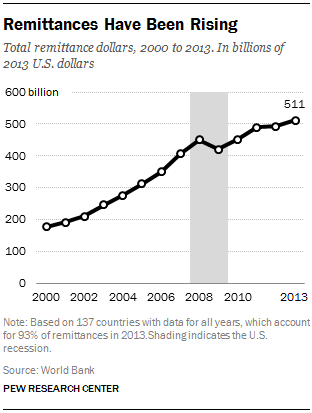 The economic importance of remittances is larger in poorer countries than in richer ones. Remittances account for 8% of the gross domestic product in low-income nations, 2% in middle-income nations and less than 1% in high-income nations, according to analysis of World Bank data. Total remittances to low- and middle-income nations are nearly three times the amount of foreign aid to those countries, the World Bank says. Since 2009, the World Bank has recognized the importance of remittances by including them in its measure of creditworthiness, allowing nations with high remittance levels to borrow more money than they otherwise could.
The economic importance of remittances is larger in poorer countries than in richer ones. Remittances account for 8% of the gross domestic product in low-income nations, 2% in middle-income nations and less than 1% in high-income nations, according to analysis of World Bank data. Total remittances to low- and middle-income nations are nearly three times the amount of foreign aid to those countries, the World Bank says. Since 2009, the World Bank has recognized the importance of remittances by including them in its measure of creditworthiness, allowing nations with high remittance levels to borrow more money than they otherwise could.
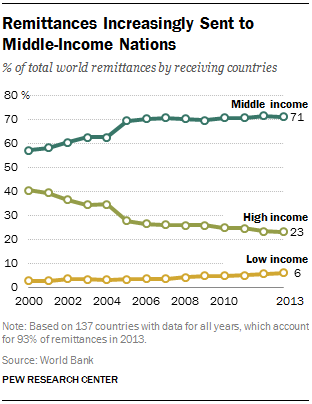 The shifting patterns in the flows of both migrants and remittances have a regional as well as economic dimension. The Middle East and North America have grown as destination regions of international migrants from 1990 to 2013, as have several Western European countries. A smaller share of international migrants lives in Asia in 2013 than three decades ago. Meanwhile, the shares of international migrants living in sub-Saharan Africa and Latin America have not changed markedly.
The shifting patterns in the flows of both migrants and remittances have a regional as well as economic dimension. The Middle East and North America have grown as destination regions of international migrants from 1990 to 2013, as have several Western European countries. A smaller share of international migrants lives in Asia in 2013 than three decades ago. Meanwhile, the shares of international migrants living in sub-Saharan Africa and Latin America have not changed markedly.
Although policy and geography are important factors in changing patterns of migration, migration researchers often cite economics to explain migration trends. The pattern of migrants increasingly living in today’s high-income countries but coming from middle-income nations reflects broader changes in the global economy. As free trade agreements for goods and services increased between middle- and high-income countries, so has the movement of people. Moreover, as the human capital and economic aspirations of people in middle-income countries have grown during the past quarter century, more of them have been able to take advantage of opportunities in high-income countries. By contrast, people living in lower-income countries may want to move but most do not have the resources to undertake the journey.
As a Destination, the U.S. Looms Large
Despite global shifts in international migration, one constant remains: The U.S. has the world’s largest number of international migrants.
The number of immigrants in the U.S. doubled from 23 million people in 1990 to 46 million in 2013. During this time, no other country has come close to the number of foreign-born people living within its borders. For example, second-ranked Russia had about 11 million immigrants in both 1990 and 2013 (many of whom had moved within the former USSR prior to 1990). Consequently, the U.S. has bolstered its lead in the number of international migrants, doubling second-place Russia in 1990 and quadrupling it by 2013.
The U.S. has also become a major recipient of migrants from key countries with large numbers of emigrants. Although the U.S. was not a leading destination of migrants born in top origin countries in 1990, things have changed considerably in a quarter century. By 2013, nearly 1-in-6 (2.1 million) migrants born in India—the top country of birth for international migrants in 2013–lived in the U.S. Almost the entirety of the 13 million migrants born in Mexico–the second highest country of birth for international migrants in 2013—also lived in the U.S.
And the U.S. is the top recipient of migrants from about a quarter of the world’s countries. In 1990, the U.S. was the top destination of migrants born in 53 countries. In 2013, that number was about the same at 52 countries.
In Other Ways, U.S. Is in the Middle of the Pack
 Even with this growth, the foreign born as a share of the total population is still considerably lower in the U.S. than in a number of other major destination nations. About 14% of the U.S. population in 2013 was foreign born, a smaller share than in Australia (28%) and Canada (21%), and significantly less than in some countries in the Persian Gulf, where the vast majorities of their populations are foreign-born workers.
Even with this growth, the foreign born as a share of the total population is still considerably lower in the U.S. than in a number of other major destination nations. About 14% of the U.S. population in 2013 was foreign born, a smaller share than in Australia (28%) and Canada (21%), and significantly less than in some countries in the Persian Gulf, where the vast majorities of their populations are foreign-born workers.
In fact, the regional origins of U.S. immigrants have become more concentrated over time with a greater share born in Latin America and the Caribbean. About 47% of all migrants living in the U.S. in 1990 were from Latin American and Caribbean countries. By 2013, 55% of all foreign-born people living in the U.S. were born in the same region.
U.S. Emigrants—A Rising Number, but Still Relatively Few
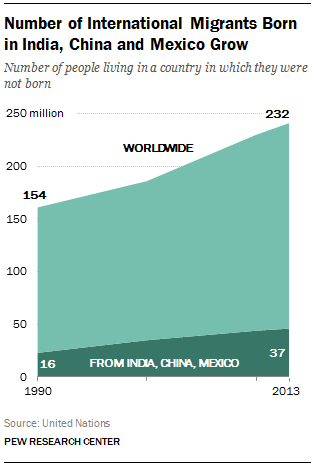 The U.S. receives many more migrants than it sends. Nonetheless, nearly 3 million Americans lived outside of the U.S. in 2013, up from 1.8 million in 1990.
The U.S. receives many more migrants than it sends. Nonetheless, nearly 3 million Americans lived outside of the U.S. in 2013, up from 1.8 million in 1990.
Compared with other origin countries, the U.S. is a relatively small source of international migrants. The U.S. ranks 20th in the list of top origin countries of international migrants, far behind world leaders such as India, Mexico and China, which together comprised about 16 million migrants in 1990 and nearly 37 million migrants in 2013.
The U.S. also has a significantly lower rate of emigration than most countries. For example, about 1% of Americans currently live outside of their country of birth, compared with about 20% of people born in several Eastern Europe countries and more than 4% of people born in countries such as the United Kingdom and Canada.
Road Map to the Report
Chapter 2 of the report looks at the share and number of international migrants in national and regional destinations, as well as trends from 1990 to 2013. Chapter 3 looks at the origin countries of international migrants and trends from 1990 to 2013. Chapter 4 looks at global trends in remittances and compares patterns in receiving nations by income category. Additional information is provided in Appendix A: Methodology and Appendix B, which lists countries included in the World Bank’s high-, middle- and low-income nation categories. Appendix C lists countries by their regional classification.
About this Report
This report examines trends in international migrant population from 1990 to 2013 and in international remittance flows from 2000 to 2013. The migration estimates in this report refer to the total number (or cumulative “stocks”) of migrants living around the world rather than to the annual rate of migration (or current “flows”). Migration and remittance patterns are analyzed for groups of low-, middle- and high-income nations, using World Bank categories; migration patterns also are analyzed for regions and individual nations. Analysis is based on migration stock data from the United Nations and migrant remittance data from the World Bank.
Research associate Phillip Connor wrote the overview and migration sections of this report; senior writer D’Vera Cohn wrote the section on remittances, based on the analysis of research associate Ana Gonzalez-Barrera. Editorial guidance was provided by Paul Taylor, executive vice president of the Pew Research Center; Michael Dimock, director of the Pew Research Center for the People & the Press; Jeffrey S. Passel, senior demographer; and James Bell, director of international survey research. Anne Shi, research associate, number-checked the report. Eileen Patten, research analyst, formatted the report. Marcia Kramer of Kramer Editing Services copy-edited the report.
A Note on Terminology
“International migrants,” as defined by the United Nations, are those living for one year or longer in a country other than the one in which they were born. Thus, many foreign workers and international students are counted as migrants, as are refugees and, in some cases, their descendants. Total migrant stock includes unauthorized or illegal immigrants living in various countries.
The economic classification of countries used in this report follows the World Bank’s categories of low-, middle- and high-income countries based on per capita, global national income (GNI) in U.S. dollars. GNI cut points separating low-, middle-, and high-income countries are based on World Bank lending rules. The country classifications in this report use 2013 country groups; however, further comparisons using the World Bank’s country groups in 1990 produce similar patterns. For a listing of countries by their economic classification, see Appendix B.
“Remittances” are funds or other assets sent to their home countries by migrants, either themselves or in the form of compensation (wages) for border, short-term and seasonal employees. The World Bank reports only remittances sent via formal channels, such as banks and other businesses that transfer money.
This report uses international migrant data published by the U.N., which classifies migrants born in territories such as Puerto Rico (a U.S. territory) or Guadeloupe (a French territory) living in the U.S. (born in Puerto Rico) or France (born in Guadeloupe) as international migrants. Similarly, U.N. international migrant data consider people born in one of the 50 U.S. states and living in a U.S. territory as international migrants. U.S. territories (including Puerto Rico) are part of the United States, and those born in U.S. territories are U.S. citizens by birth. Migrants from U.S. territories living in the U.S. are not classified as international migrants in foreign-born population estimates published by the U.S. Census Bureau or the Pew Research Center’s Hispanic Trends Project.


 Interactive Remittance Flows Worldwide in 2015
Interactive Remittance Flows Worldwide in 2015